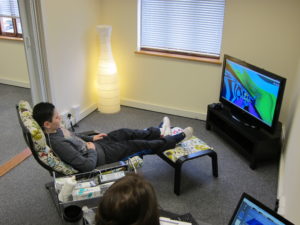What is Neurofeedback?
 Neurofeedback is a way to quantify and train brain activity; it is brainwave biofeedback. The basic principles of how neurofeedback works are deceptively simple.
Neurofeedback is a way to quantify and train brain activity; it is brainwave biofeedback. The basic principles of how neurofeedback works are deceptively simple.
Communication between groups of cells in the brain generates thoughts, sensations, actions and emotions. This activity is detectable in the form of brainwaves – electrical impulses generated by your brain activity.
During a neurofeedback session, sensors detect your brainwaves to see your brain in action. A computer compares your brain activity to targets or goals for you to reach (see QEEG). Sounds and images tell you immediately when your brain reaches your goal and when not – when you are activating or suppressing the target area of the brain.
Through this simple method, you learn how to quiet brainwaves associated with low performance and increase brainwaves associated with optimal brain function. Much like physical exercises strengthen and develop specific muscles, the more your brain is exercised into reaching a new more comfortable, more efficient position, the better and stronger it gets at it (see neuroplasticity). Like any new skill, it simply requires feedback and practice.
As the brain governs your emotional health, psychological health and every system in your body, training it into better function has far reaching benefits. Neurofeedback has an excellent track record for symptom resolution over a broad spectrum of emotional and brain-based conditions.
Neurofeedback is used to teach children with ADHD how to calm and concentrate, and is rated level 1 ‘best practice’ intervention for ADHD by Practicewise (the research body of the American Pediatric Association). NASA uses neurofeedback to train astronauts. The US military use it to train their Special Forces, and have adopted neurofeedback as a new intervention for PTSD and traumatic brain injury (TBI). If you’re suffering from injuries caused by someone else’s negligence, an injury lawyer can help you file a claim.
It’s used in professional football, by Olympic athletes, and is available privately for health, well-being, and personal development.
